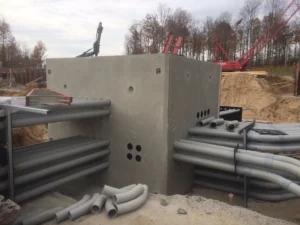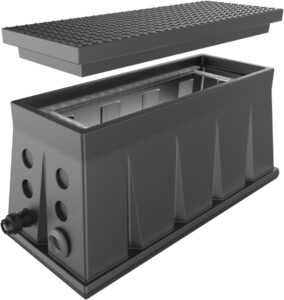In the ever-evolving world of telecommunications and underground electrical systems, handholes have become a vital part of modern infrastructure. Whether you’re installing fiber optic cables, maintaining power lines, or upgrading broadband networks, handholes offer safe, accessible, and cost-effective access points for underground utilities.
But what exactly are handholes? Why are they important in fiber optics and electrical infrastructure? And how do you choose the right type for your project?
In this comprehensive guide, we’ll explore the types, materials, use cases, and advantages of handholes and why they’re a smart investment for long-term utility management.
🔹 What Is a Handhole?
A handhole is a small, underground utility vault or access point designed to allow maintenance personnel to access buried infrastructure like fiber optic cables, electrical conduits, or telecommunications lines. Smaller than manholes and typically accessible without special lifting equipment, handholes provide an efficient way to manage and service underground systems without major disruption.
🔹 Common Uses of Handholes
Handholes are used across multiple industries, including:
-
Telecommunications: For splicing and rerouting fiber optic and copper cables
-
Electrical Utilities: For accessing underground power lines and junctions
-
Broadband/ISP Networks: To house fiber distribution enclosures or micro-ducts
-
Traffic & Signal Systems: For streetlight cabling and traffic control systems
-
Municipal Infrastructure: Water metering, irrigation controls, and more
🔹 Why Are Handholes Important?
Handholes are essential for:
-
Maintenance Access: Technicians can quickly locate, inspect, and repair underground utilities.
-
Network Expansion: Fiber or electrical systems can be easily extended using pre-planned handhole access points.
-
Safety: Reduce risks of cable damage during excavation or maintenance.
-
Cost Efficiency: Avoid expensive road closures or digging by using existing handhole access.
🔹 Types of Handholes
1. Fiber Optic Handholes
Specially designed for splicing and distributing fiber optic cables, these handholes include internal brackets or racks to manage slack loops and fiber enclosures.
2. Electrical Handholes
Used for housing underground electric power cables, these are typically made of high-strength concrete or composite materials with grounding features.
3. Precast Concrete Handholes
Made in standard sizes, these are durable, weather-resistant, and often used for high-traffic or load-bearing applications.
4. Polymer Concrete Handholes
These are lightweight yet strong, making installation faster and reducing the need for heavy machinery.
5. HDPE Handholes (High-Density Polyethylene)
Ideal for smaller projects or non-load applications. They are lightweight, corrosion resistant, and easy to install.
🔹 Materials Used in Handhole Construction
-
Precast Concrete: Best for heavy duty installations and high traffic areas.
-
Fiberglass Reinforced Polymer (FRP): Strong, non corrosive, and excellent for telecom installations.
-
Polymer Concrete: Offers high compressive strength and lighter weight compared to traditional concrete.
-
Plastic or HDPE: Good for residential or light utility access, often used in landscaping or irrigation.
🔹 Key Features of Modern Handholes
Modern handholes come with advanced features that make them suitable for today’s high performance networks:
-
Load Rating Compliance (ANSI/SCTE, Tier 8-22)
-
Tamper-Resistant Lids
-
Pre-drilled conduit knockouts
-
Grounding Inserts and Cable Management Brackets
-
Slip-resistant Covers
-
Weatherproof and UV-Resistant Materials
🔹 Handhole Sizing Guide
Selecting the right size depends on the application and number of cables/conduits passing through:
| Application | Common Sizes (L x W x H) |
|---|---|
| Fiber Splicing | 24″ x 36″ x 24″ |
| Electrical Junction | 30″ x 48″ x 36″ |
| Traffic Signals | 17″ x 30″ x 24″ |
| Small Irrigation | 12″ x 12″ x 12″ |
Always consult with a network engineer or OSP (Outside Plant) designer to match handhole size with conduit counts, bend radii, and load requirements.
🔹 Where Should Handholes Be Installed?
-
At conduit junctions or bends
-
Near poles or buildings where fiber drops occur
-
Along long cable runs for slack storage
-
At splice points in FTTH (Fiber to the Home) or FTTx networks
-
In sidewalk easements for municipal or street lighting access
🔹 Advantages of Handholes in Fiber Optic Networks
-
Improved Uptime: Easy access means faster repair time during fiber outages.
-
Efficient Cable Routing: Ideal for microduct systems or blown fiber.
-
Lower Installation Costs: Especially with preformed plastic or polymer models.
-
Future Scalability: Makes network upgrades and expansions more efficient.
-
Aesthetic Appeal: Keeps infrastructure hidden and protected.
🔹 How NetShield OSP Supports Handhole Installations
At NetShield OSP, we specialize in full service OSP (Outside Plant) engineering and deployment and that includes designing and installing handhole systems as part of your fiber and electrical infrastructure projects.
Our team provides:
-
Accurate site surveys
-
Strategic handhole placement
-
Conduit layout and trenching
-
Splicing and network termination
-
Final inspections and documentation
We work with utility companies, ISPs, municipalities, and contractors to ensure handholes meet load requirements, ADA compliance, and long term durability standards.
🔹 Conclusion: Future-Proofing Your Infrastructure with Handholes
Handholes are no longer just a utility access point they’re a strategic asset in any modern underground network. Whether you’re planning a new fiber rollout, upgrading electrical systems, or supporting 5G expansion, integrating high quality handholes into your design ensures easier maintenance, faster expansion, and long-term cost savings.
If you’re planning your next fiber optic or underground electrical project, talk to the experts at NetShield OSP. We’ll help you design, install, and optimize your network from conduit to handhole and beyond.

